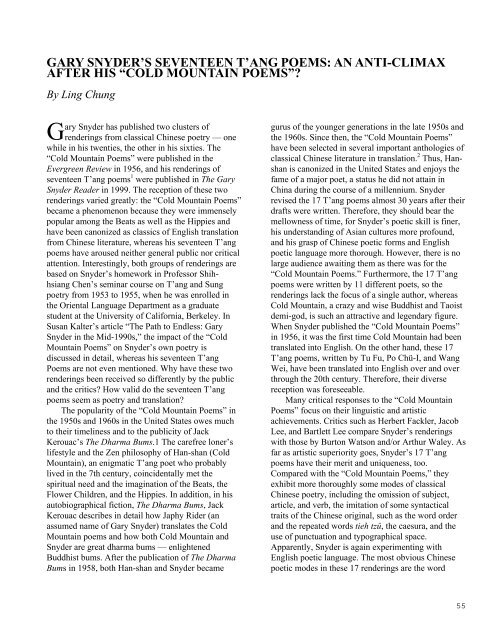their - The University of Texas at Dallas
their - The University of Texas at Dallas
their - The University of Texas at Dallas
Create successful ePaper yourself
Turn your PDF publications into a flip-book with our unique Google optimized e-Paper software.
GARY SNYDER’S SEVENTEEN T’ANG POEMS: AN ANTI-CLIMAX<br />
AFTER HIS “COLD MOUNTAIN POEMS”<br />
By Ling Chung<br />
G<br />
ary Snyder has published two clusters <strong>of</strong><br />
renderings from classical Chinese poetry — one<br />
while in his twenties, the other in his sixties. <strong>The</strong><br />
“Cold Mountain Poems” were published in the<br />
Evergreen Review in 1956, and his renderings <strong>of</strong><br />
seventeen T’ang poems 1 were published in <strong>The</strong> Gary<br />
Snyder Reader in 1999. <strong>The</strong> reception <strong>of</strong> these two<br />
renderings varied gre<strong>at</strong>ly: the “Cold Mountain Poems”<br />
became a phenomenon because they were immensely<br />
popular among the Be<strong>at</strong>s as well as the Hippies and<br />
have been canonized as classics <strong>of</strong> English transl<strong>at</strong>ion<br />
from Chinese liter<strong>at</strong>ure, whereas his seventeen T’ang<br />
poems have aroused neither general public nor critical<br />
<strong>at</strong>tention. Interestingly, both groups <strong>of</strong> renderings are<br />
based on Snyder’s homework in Pr<strong>of</strong>essor Shihhsiang<br />
Chen’s seminar course on T’ang and Sung<br />
poetry from 1953 to 1955, when he was enrolled in<br />
the Oriental Language Department as a gradu<strong>at</strong>e<br />
student <strong>at</strong> the <strong>University</strong> <strong>of</strong> California, Berkeley. In<br />
Susan Kalter’s article “<strong>The</strong> P<strong>at</strong>h to Endless: Gary<br />
Snyder in the Mid-1990s,” the impact <strong>of</strong> the “Cold<br />
Mountain Poems” on Snyder’s own poetry is<br />
discussed in detail, whereas his seventeen T’ang<br />
Poems are not even mentioned. Why have these two<br />
renderings been received so differently by the public<br />
and the critics How valid do the seventeen T’ang<br />
poems seem as poetry and transl<strong>at</strong>ion<br />
<strong>The</strong> popularity <strong>of</strong> the “Cold Mountain Poems” in<br />
the 1950s and 1960s in the United St<strong>at</strong>es owes much<br />
to <strong>their</strong> timeliness and to the publicity <strong>of</strong> Jack<br />
Kerouac’s <strong>The</strong> Dharma Bums.1 <strong>The</strong> carefree loner’s<br />
lifestyle and the Zen philosophy <strong>of</strong> Han-shan (Cold<br />
Mountain), an enigm<strong>at</strong>ic T’ang poet who probably<br />
lived in the 7th century, coincidentally met the<br />
spiritual need and the imagin<strong>at</strong>ion <strong>of</strong> the Be<strong>at</strong>s, the<br />
Flower Children, and the Hippies. In addition, in his<br />
autobiographical fiction, <strong>The</strong> Dharma Bums, Jack<br />
Kerouac describes in detail how Japhy Rider (an<br />
assumed name <strong>of</strong> Gary Snyder) transl<strong>at</strong>es the Cold<br />
Mountain poems and how both Cold Mountain and<br />
Snyder are gre<strong>at</strong> dharma bums — enlightened<br />
Buddhist bums. After the public<strong>at</strong>ion <strong>of</strong> <strong>The</strong> Dharma<br />
Bums in 1958, both Han-shan and Snyder became<br />
gurus <strong>of</strong> the younger gener<strong>at</strong>ions in the l<strong>at</strong>e 1950s and<br />
the 1960s. Since then, the “Cold Mountain Poems”<br />
have been selected in several important anthologies <strong>of</strong><br />
classical Chinese liter<strong>at</strong>ure in transl<strong>at</strong>ion. 2 Thus, Hanshan<br />
is canonized in the United St<strong>at</strong>es and enjoys the<br />
fame <strong>of</strong> a major poet, a st<strong>at</strong>us he did not <strong>at</strong>tain in<br />
China during the course <strong>of</strong> a millennium. Snyder<br />
revised the 17 T’ang poems almost 30 years after <strong>their</strong><br />
drafts were written. <strong>The</strong>refore, they should bear the<br />
mellowness <strong>of</strong> time, for Snyder’s poetic skill is finer,<br />
his understanding <strong>of</strong> Asian cultures more pr<strong>of</strong>ound,<br />
and his grasp <strong>of</strong> Chinese poetic forms and English<br />
poetic language more thorough. However, there is no<br />
large audience awaiting them as there was for the<br />
“Cold Mountain Poems.” Furthermore, the 17 T’ang<br />
poems were written by 11 different poets, so the<br />
renderings lack the focus <strong>of</strong> a single author, whereas<br />
Cold Mountain, a crazy and wise Buddhist and Taoist<br />
demi-god, is such an <strong>at</strong>tractive and legendary figure.<br />
When Snyder published the “Cold Mountain Poems”<br />
in 1956, it was the first time Cold Mountain had been<br />
transl<strong>at</strong>ed into English. On the other hand, these 17<br />
T’ang poems, written by Tu Fu, Po Chü-I, and Wang<br />
Wei, have been transl<strong>at</strong>ed into English over and over<br />
through the 20th century. <strong>The</strong>refore, <strong>their</strong> diverse<br />
reception was foreseeable.<br />
Many critical responses to the “Cold Mountain<br />
Poems” focus on <strong>their</strong> linguistic and artistic<br />
achievements. Critics such as Herbert Fackler, Jacob<br />
Lee, and Bartlett Lee compare Snyder’s renderings<br />
with those by Burton W<strong>at</strong>son and/or Arthur Waley. As<br />
far as artistic superiority goes, Snyder’s 17 T’ang<br />
poems have <strong>their</strong> merit and uniqueness, too.<br />
Compared with the “Cold Mountain Poems,” they<br />
exhibit more thoroughly some modes <strong>of</strong> classical<br />
Chinese poetry, including the omission <strong>of</strong> subject,<br />
article, and verb, the imit<strong>at</strong>ion <strong>of</strong> some syntactical<br />
traits <strong>of</strong> the Chinese original, such as the word order<br />
and the repe<strong>at</strong>ed words tieh tzû, the caesura, and the<br />
use <strong>of</strong> punctu<strong>at</strong>ion and typographical space.<br />
Apparently, Snyder is again experimenting with<br />
English poetic language. <strong>The</strong> most obvious Chinese<br />
poetic modes in these 17 renderings are the word<br />
55

















